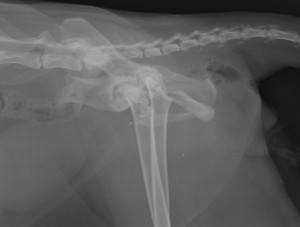A much loved 13-year-old cat called Chalk presented to us at West Midlands Veterinary Referrals after severe trauma, including a fracture/luxation on the right side of the pelvis and multiple fractures affecting the left side of the pelvis.
This left side also had no apparent sensation or nerve/muscle motor function remaining to the distal limb. Areas of the soft tissues /muscles of the upper left hind limb were also apparently devitalised – they had lost their blood supply in the trauma and were “dead”. Even if the fractures on this left side had been fixed with plates etc, the prognosis for the return of nerve function to the left hind limb was very questionable. The placement of metalwork in the devitalised environment would have carried a genuine risk of infection. So we advised a left hemipelvectomy – an amputation of the severely injured hind limb and removal of the underlying pelvic bone fragments. Chalk needed help with early mobility post-op but returned to a very acceptable level of mobility within a few weeks.
A second case involved a toy breed dog that presented with chronic constipation over a year after conservative (non-surgical) management of a pelvic fracture elsewhere. The fracture had healed with a mass of new bone called a callus. This and the poor alignment of the fragments had led to a narrowing of the pelvis dimensions through which the dog was struggling to pass faeces. The faeces were then accumulating “upstream” in the large bowel, causing significant distress.
Initially, we re-cut the pelvis with a bone saw and used a plate to fix it into a position with improved pelvic dimensions. The patient wasn’t amenable, and although initial results were encouraging, constipation persisted in the months following surgery. So we removed one side of the pelvis as part of hind limb amputation, and the patient could pass faeces much more efficiently, and could still get around just fine on three legs.
21st October 2013





